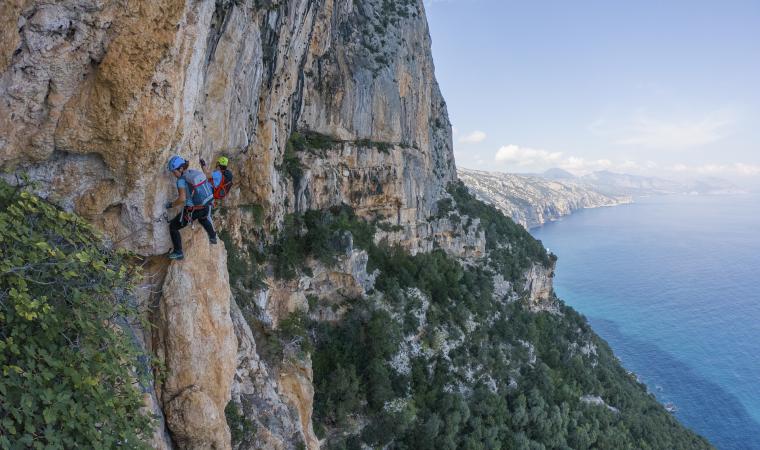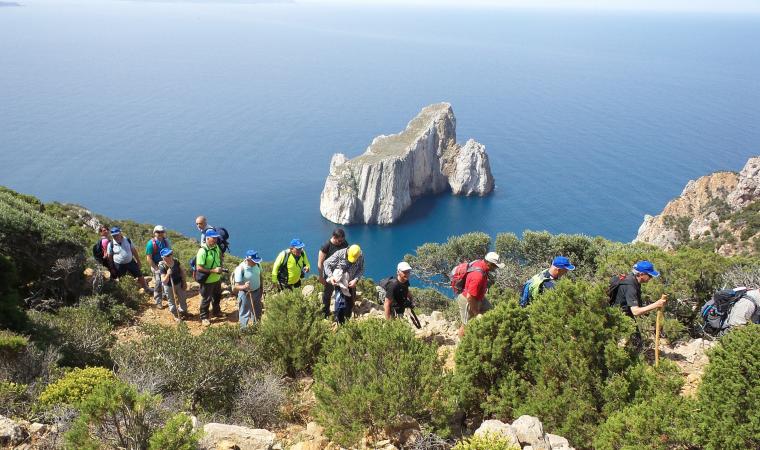
With climbing opportunities available year-round thanks to the island’s pleasant climate that ensures optimal climbing conditions, Sardinia stands as an enticing destination for those seeking varied and breathtaking routes amidst its natural beauty. Providing unforgettable experiences, its diverse landscape offers a wide range of climbing walls, grades and styles suitable for individuals of all levels, whether you're just starting out on your climbing journey or you're an experienced climber ready to push your limits and showcase your skills in Sardinia. From the dramatic limestone crags of Cala Gonone and the mesmerizing granite spires of Nuoro, Sardinia really does have it all. Discover your next climbing adventure in Sardinia's diverse terrains!
WHAT TYPES OF CLIMBING WALLS CAN YOU FIND IN SARDINIA
Sardinia is home to multiple types of rock formations that cater to enthusiasts of all levels seeking to satisfy their adventurous spirit.
Limestone
Limestone climbing walls are characterized by their flatter, polished finish, making them a harder rock face to conquer. Areas such as the Cala Gonone and Capo Caccia provide climbers with impressive routes.
Granite
Featuring natural cracks and slabs, Sardinia offers a variety of granite walls. From Nuoro in the northeast, Oristano in the west, to the area surrounding the capital of Cagliari, there is a plethora of granite rock routes for all types of climbers.
Basalt
Basalt climbing areas in Sardinia are less common but equally exhilarating. A type of igneous rock, these walls often boast grooves and cracks that are great for improving climbing techniques. The area to the north of Oristano offers impressive basalt cliffs that rise dramatically from the coastline.
WHAT TYPES OF OUTDOOR CLIMBING CAN BE DONE IN SARDINIA
Sardinia offers two main types of outdoor climbing: sports routes and long/multi-pitch routes.
Sport routes / crag routes
Commonly referred to as crag routes, these are climbing routes equipped with bolts permanently built into the rock face for protection. Here, climbers wear harnesses and are attached to a rope that is controlled by a second person on the ground, known as the belayer. Some of the island's most renowned crag routes can be found in the iconic Domusnovas area, as well as the striking sea cliffs of Masua.
Long or multipitch routes
This involves ascending cliff faces in several stages, or “pitches”, providing climbers with the chance to scale towering formations. These routes require technical proficiency and typically require two half ropes or one full rope for safety. Punta Giradili, a famous limestone spire rising from the Supramonte plateau on Sardinia’s east coast, is a prime example of such a route.
CLIMBING IN NORTHERN SARDINIA
Northern Sardinia offers an array of climbing opportunities year-round thanks to its favourable Mediterranean climate. Whether you're a novice or an experienced climber, this region offers some of the best climbing routes to help you develop your skills.
Climbing in the Sassari area
The climbing options in the Sassari area are great for those looking for shorter climbs that only take a few hours, with beginner-friendly routes starting from as low as a grade 4 and advancing all the way to an 8b for more proficient climbers. Most of the walls in north-west Sardinia are composed of limestone and are mainly single-pitch sports routes measuring up to 35 meters tall, with the shortest route at Littu measuring only 4 meters. Nearby, you can explore the picturesque town of Alghero or discover the rich history of the town of Sassari itself.
Climbing in the Alghero area
In the Alghero area, the routes start at an easy grade 3 at the Rocca della Bagassa, ascending to an 8b for those who seek a challenge. According to time constraints, there are routes that only require a few hours or take an entire day. The majority of climbing spots in this area are made from limestone, but are more varied in height, averaging out at 20 meters, and a few multi-pitch routes extending up to 140 meters tall. For days off, there are many restaurants, historical sites and activities in Alghero itself, and an abundance in north-east Sardinia.
Climbing in the Isili area
Spanning from an easy 4 to an expert-level 8c, climbers of all abilities can enjoy a challenge in the Isili area of Sardinia. While this area in the centre of Sardinia caters to most types of climbers, it's particularly renowned for its abundance of sports routes and bouldering opportunities on limestone cliffs. Granite and basalt walls are scarce here. Routes vary in length from 5-50 meters, meaning that they can be finished in under a few hours. Nearby towns, such as Oristano, make for convenient bases, with a plethora of cafes and restaurants where you can relax and unwind.
Climbing in the Samugheo area
Climbing in the Samugheo area of Sardinia is primarily tailored to intermediate and advanced climbers, as it offers limited beginner-friendly routes. The average climbing routes here range from moderate (5a) to challenging (8b), making it an ideal destination for those seeking more demanding climbs. These routes vary in length, typically taking 30 minutes to several hours to complete, and reach heights of around 90 meters. Samugheo features traditional and calcarenite limestone cliffs, providing climbers with exceptional outdoor opportunities, including sport and multi-pitch routes. Nearby towns include Cagliari, offering convenient access to amenities and accommodation.
Climbing in the Monte Arci area
Climbing in the Monte Arci area of Sardinia offers a unique experience due to its location around the majestic Monte Arci Mountain. Perhaps more suitable for those with climbing experience, you'll find routes ranging from 4 to 8a+, with climbs typically lasting up to several hours and lengths varying from 10-30 meters. Composed of three volcanic basalt towers, the highest point of the mountain reaches 812 meters. The surrounding area is dotted with towns such as Mogoro to the south, serving as a convenient base. Beyond climbing, the Parco Monte Arci boasts fascinating geological formations and historical sites.
Climbing in the Ogliastra area
The area of Ogliastra is a unique location as it offers climbers single- and multi-pitch sports routes, deep-water soloing and bouldering. Most of the walls in this area are limestone, providing great climbing opportunities year-round. The route grades here range from an easy 3, to a challenging 8c, and offer you the unique opportunity to climb Cala Gonone. You can choose from quick climbs or longer, full-day multi-pitch adventures, with route lengths spanning from 7 to 160 meters. Larger towns such as Tortolì provide convenient bases, and fascinating attractions include the Gorropu Canyon or Cala Goloritzé beach.
Climbing in the Supramonte area
In Sardinia's Supramonte region, the climbing terrain primarily consists of limestone and granite walls and is the ideal area for climbers who prefer longer, multi-pitch routes. The official climbing grades here fall within the range of 4 to 8b+, with the duration of the climbs tending to take up to a whole day due to their height. Although there are shorter routes, starting from quick 10-meter climbs, most of the routes surpass 100 meters, with some multi-pitch routes exceeding 600 meters. Towns like Nuoro and Oliena are nearby, serving as useful bases for climbers.
Southern Sardinia offers climbers an excellent offer of rugged coastal routes and diverse rock formations. With its mild Mediterranean climate, you can enjoy thrilling climbs in this stunning region throughout the seasons.
Climbing in the Iglesias area
Climbing in the Iglesias area of south Sardinia offers a range of climbing options. While there are routes for beginners with an official grading of 4, the area primarily caters to experienced sports climbers, offering a variety of limestone, granite and basalt single- and multi-pitch routes graded up to an 8b. The routes also vary in length, from 7-meter climbs ideal for a quick afternoon adventure to endeavours hundreds of meters tall that can take a day to complete. Conveniently located near the capital of Cagliari, climbers have easy access to accommodation, shops and restaurants, and the tranquil Sardinian coastline.
Climbing in the Buggerru area
Buggerru, a smaller but exciting area to explore via climbing, features routes with official grades starting at an easy 4 and spanning to a more difficult 8b, ensuring that both novices and seasoned climbers can find suitable challenges. The climbing routes in this area vary in height, with some reaching up to 450 meters tall, making it suitable for those seeking both short single-pitch sports climbs and longer multi-pitch traditional climbs. The area is primarily characterized by striking limestone cliffs, which are characteristic of Sardinia. The nearest town is Buggerru itself which provides ample amenities and accommodation.
Climbing in the Domusnovas area
The routes surrounding the town of Domusnovas are some of the most inclusive with regard to their official grading. Offering predominantly sports routes measuring an average of 25 meters, these routes span from a grade 4 to a grade 9a+, a grade reserved for only the most experienced sports climbers. The time required for each climb varies, but in this area, climbers can complete most routes within a few hours. Cagliari and Iglesias, in addition to Dumonovas, offer convenient access points to the climbing areas, and the region boasts many cultural and natural attractions for those looking to explore further.
CLIMBING IN SARDINIA: THE IDEAL TIME?
Climbing in Sardinia is an undeniable year-round pursuit thanks to the island’s range of climbing options that cater to varying weather conditions throughout the seasons. However, Sardinia in spring and autumn stand out as the prime times to explore the island's impressive routes. With cooler temperatures, less humidity and fewer crowds in Sardinia in the autumn, winter and spring, these periods offer the perfect balance for climbers looking to make the most of their Sardinian experience. So, whether you're a seasoned climber or just starting out, planning your visit during Sardinia in the winter, spring or autumn is highly recommended.







